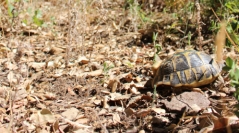

 Naturae
2020 (6) - Pages 101-111
Naturae
2020 (6) - Pages 101-111Accurate evaluation of animal home range is crucial for field managers. It provides key information to determine the surface of areas that require protection and to limit population fragmentation. Home ranges (MCP) were obtained in 165 Hermann tortoises radio-tracked across the whole activity season in nine populations of continental France. Our study shows that mean home range was considerably larger compared to previous estimates: 9ha (median 5.2ha) versus 2ha. This strong difference is explained by the small sample sizes collected during short time periods in previous studies. Our intensive monitoring during 10 years provides more realistic estimates. In agreement with the literature, we observed wide inter-individual variations (0.6ha to 95.0ha). Home range size increased in spring, during the peak of activity, and tended to stabilize in summer or in autumn. It is essential to take into account realistic home range estimates, especially maximal values (>15ha), to establish suitable protected areas and to create corridors among them. Large populations occupying large areas with diverse habitats are more likely to adapt global and climatic changes. Protecting large surfaces (e.g. hundreds of hectares) connected by dedicated infrastructures (under road passages) is recommended to maintain a high genetic diversity and to provide a wide range of microhabitats.
Mediterranean habitat, reptile, radio-tracking, minimum convex polygon, protected areas.